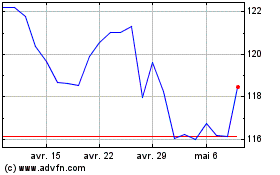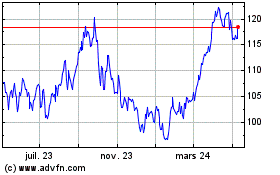Falling Crude Prices Test Big Oil's New Financial Discipline
29 Novembre 2018 - 1:36PM
Dow Jones News
By Sarah Kent
Years of painful restructuring have left big oil companies
better positioned to handle the recent decline in oil prices, but
another prolonged downturn could reinforce newfound financial
discipline that has already led to concerns about
underinvestment.
Oil giants like Exxon Mobil Corp., Chevron Corp. and Royal Dutch
Shell PLC have slashed costs and cut spending in recent years in an
effort to convince investors they can be resilient--and
profitable--even when oil prices are volatile.
Those efforts have paid off. The industry's biggest players are
churning out cash this year and improving returns to shareholders.
The average Brent oil price that the world's biggest western oil
companies need to break even, has fallen from more than $100 a
barrel before the price crash in 2014 to less than $50 a barrel
this year, according to Edinburgh-based consulting firm Wood
Mackenzie.
As prices have tumbled, that has left executives feeling
vindicated for remaining cautious, and well prepared for the
prospect of fresh pain ahead.
"We're very confident in the outlook for the company, not so
much in the outlook for the oil market," BP PLC chief financial
officer Brian Gilvary said.
BP has said it would be able to cover its capital budget and
shareholder payouts with cash from operations with oil at $50 a
barrel this year, and is working to bring that number down to
between $35 and $40 a barrel by 2021.
While the recent fall in oil prices is likely to reinforce the
industry's financial discipline, a harsher test could be ahead
should prices decline further. The price of international benchmark
Brent crude has plunged around 30% since its October peak, when it
reached a four-year high of more than $85 a barrel. American
benchmark West Texas Intermediate has also plummeted, falling below
$50 a barrel this week.
Big international companies generally use the Brent crude price
as a marker for strategic planning. At around $60 a barrel, it is
still at levels where the companies have shown they can comfortably
make healthy profits and it is unlikely to cause any major changes
to strategic thinking.
But if the slide continues below the $60 a barrel marker, the
broader industry could struggle to generate enough cash to fully
cover financial commitments. "$55 a barrel and below is when a lot
of companies start going cash-flow negative. Clearly if we go back
down to $30 a barrel, it's a very challenging environment," said
Wood Mackenzie's senior vice president for corporate research Tom
Ellacott.
Even if prices remain around $60 a barrel, executives face a
pressing dilemma: To maintain and grow production, they need to
keep investing in new projects, but price volatility is likely to
feed extreme caution around sanctioning large and costly
developments.
Historically, companies have ratcheted up spending in the
aftermath of an oil price decline, taking advantage of a healthier
investment environment. Not this time. Even when prices were rising
through most of 2018, big oil executives repeatedly reiterated
their mantra of disciplined spending.
"I think people--they're thinking the history is going to color
our future, and that's really not the case," Chevron Chief
Financial Officer Patricia Yarrington told analysts earlier this
month. "We have growth potential, but it's going to be at a much
lower capital rate."
Chevron is spending about half what it was in 2014 on finding
and developing new projects. Both Shell and BP have set clear
limits around their spending through the end of the decade. Exxon
stands out as an exception for laying out plans to substantially
increase capital expenditures in the coming years.
The companies say they can now do more for less and are still
growing production. On top of reigning in spending, they've
redesigned and simplified new projects and renegotiated expensive
contracts--moves they say have helped to permanently lower
costs.
Where companies have returned to drilling, they are doing it
within a strict budget. Shell, for instance, spent three years
looking at ways to make its Vito project in the Gulf of Mexico more
economic before greenlighting the development earlier this year. By
simplifying the original design and working more closely with its
contractors, the company was able to reduce costs by more than 70%
and bring the project's break-even oil price down below $35 a
barrel. Once it is up and running in 2021, Vito is expected to
produce up to 100,000 barrels of oil equivalent a day.
But some analysts and executives have raised concerns that the
industry still needs to start investing more to avoid a supply
crunch that could send prices spiking higher within the next few
years.
"Overall in the industry, the current level of investment is
probably not enough to support demand," Equinor CEO Eldar Saetre
said. "You've seen three or four years now with low investment
levels and few FIDs, and that needs to come up."
Write to Sarah Kent at sarah.kent@wsj.com
(END) Dow Jones Newswires
November 29, 2018 07:21 ET (12:21 GMT)
Copyright (c) 2018 Dow Jones & Company, Inc.
Exxon Mobil (NYSE:XOM)
Graphique Historique de l'Action
De Juin 2024 à Juil 2024

Exxon Mobil (NYSE:XOM)
Graphique Historique de l'Action
De Juil 2023 à Juil 2024
